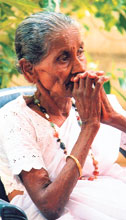The World Bank last year rated Sri Lanka as the country with the fastest growing aged population in South East Asia. Therefore, it is time for the government and health-care policy makers to consider it as a matter of urgency not only to face the health-care needs but also the socio-economic and cultural issues connected with a fast-aging population.
A 2004 survey indicates that the percentage of people over 60 years old is around 9.8% and would rocket to 23% by 2021. Currently, the average life expectancy for a Sri Lankan female is 72 years and for a male 69 years, with a further increase over the next decade. Longer life beyond 60 years necessarily means a life with a lot of challenges and burdens in terms of multiple illnesses and disabilities secondary to old age. Long life is a blessing when the quality of life is acceptable and bereft of undue stress and social discrimination.
The needs of the aging are diverse and sometimes costly. Neglect of the elderly amounts to the abuse of their rights. Therefore, their needs should be safeguarded by appropriate legal enactments. The special needs of the elderly should also be identified and addressed.
Is Sri Lanka equipped to handle these demographic changes?
The estimated figure for the elderly population in 2050 is a staggering 27.6%. With more than a quarter of the population falling into the 'aged' category, the economic challenges would be enormous. A fair proportion of the health-care budget would have to be diverted to cater to the needs of these senior citizens.
Geriatric medicine
Elderly-care medicine is called geriatric medicine in well-planned health-care systems in the developed world and involves a multi-disciplinary team. Each area health service has many hospitals looking after the health needs of the aged. Even the hospitals in rural areas will have at least one geriatric ward, supplemented by community geriatric services, clinics, and also home-based care provided by trained nursing staff.
The separate establishment of units/wards dedicated to elderly patients may be beneficial for a number of reasons. Firstly, the health care needs of the elderly are significantly different to those of younger people.
The disease pattern among the elderly will indicate more of the non-communicable diseases like high blood pressure; high cholesterol; diabetes; stroke and neurological illness like Parkinson's and dementia; mobility-related issues and urinary and faecal incontinence, while younger people will tend to have more of the communicable diseases like infections and inflammatory conditions. If both groups are managed in one ward, the chances of cross-infections remain high among the elderly, increasing morbidity and mortality and also adding to hospital costs due to prolonged hospitalization.
Secondly, the bed-occupancy in an aged-care ward will be longer due to many reasons including multiple co-morbidities and varying care needs.
When elderly people are managed in the same ward as younger people, the latter group will have to compete with the more disabled elderly patients for bed-priority.
Thirdly, most of the ailments in the aged will require rehabilitation as part of the therapy which calls for more allied health inputs and equipment. Hence a special ward dedicated to geriatric patient care will be useful not only from the perspective of the elderly patient but also for the efficient management of other patients in overcrowded medical units.
Such a system would require the channelling of a large sum of money for infrastructure planning and provision of manpower. Thus it would become an economic challenge for a developing nation like Sri Lanka. This is why health-care policy makers need to plan the provision of quality care at low cost starting at rural hospital level.
Geriatric units at each hospital with currently available facilities will not be a problem if begun as an outpatient service. A close look at the long queues at a government hospital medical clinic will reveal that a majority are in the geriatric group. This congestion can be minimized while offering an effective service if geriatric clinics are opened up.
As most of the elderly do not have a fixed income and are dependent on their children, relatives or friends for support, social welfare systems need to be developed for the most vulnerable at both home and community-based levels.
Institutional care for the elderly also needs to be looked at seriously, although currently not well developed due to many reasons including cultural and social stigma.
Safeguarding the physical, mental and social well-being of the elderly is an issue that needs to be addressed at all levels of the health-care delivery system in Sri Lanka if we are to offer the privilege of graceful aging to our senior citizens. The concept of elderly-care medicine also needs to be incorporated into the medical curriculum.
Percentage of people over 60 |
2004 |
2001 |
9.8% |
23% |
(The writer is Specialist Registrar in Geriatrics at the Bankstown Teaching Hospital in Sydney, Australia) |

